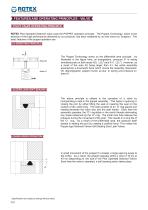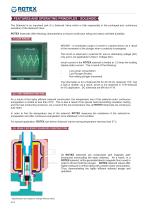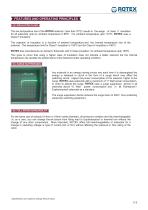 Website:
Rotex Automation Limited
Website:
Rotex Automation Limited
Group: ROTEX GROUP
Catalog excerpts

FLUID CONTROL SYSTEM FEATURES AND OPERATING PRINCIPLES - VALVE DIRECT ACTING VALVE (A) The Solenoid is directly responsible for opening and closing the po rts and thereby controlling the direction of fluid flow in the Direct Acting Solenoid Valve. (B) On energising the Solenoid, t he e lectromagnetic field generated pu lls the plunger thereby blocking orifice at Port-3 and opening passage from Port-1 to Port-2. On de-energising the solenoid, plunger drops down, thus opening passage between Port-2 and Port-3 and blocks Port-1. In Normally Closed (NC) 3/2 Way Valve, pressure is applied at Port-1, apparatus is connected at Port-2 and Exhaust is at Port-3. In Normally Open (NO) 3/2 Way Valve, pressure is applied a t Port-3, apparatus is connected at Port-2 and Exhaust is at Port-1. CAUTION 3/2 NC Valve cannot be converted to 3/2 NO Valve by change of pressure connection. The valve needs change of Springs and other Components which is to be done at the assembly stage. PILOT OPERATED VALVE : Larger flow calls for bigger orifice. In a Direct Acting Valve having a bigger orifice, a strong spring is required to ho ld the p ressure against the b igger orifice, requiring a high power solenoid. The high power consumption leads to high inrush, overheating and high back surges. To overcome such situations, ROTEX offers Internal Pilot Operated Solenoid Valve which uses the media pressure to operate the valve. Working principles are : Specifications are subject to change without notice.
Open the catalog to page 1
FLUID CONTROL SYSTEM FEATURES AND OPERATING PRINCIPLES - VALVE PILOT VALVE OPERATING PRINCIPLE ROTEX Pilot Operated Solenoid Valve uses the POPPET operation principle. The Poppet Technology, which is the essence of the high performance delivered by our products, has been mastered by us ever since our inception. The basic features of the poppet operation are : (1) OPERATING PRINCIPLE The Poppet Technology works on the differential area principle. As illustrated in the figure here, on energisation, pressure P1 is acting simultaneously on both areas A2( / 4D22) and A1( / 4D12). However, as a...
Open the catalog to page 2
FLUID CONTROL SYSTEM FEATURES AND OPERATING PRINCIPLES - VALVE (4) NON WEARING PARTS The poppet construction utilises a mushroom head piston with un ique floating ‘O’ rings. These ‘O’ rings, fitted on the piston, do not slide during the piston movement but, f lex in their position. As a result of this non-wearing characteristic, the seals last for millions of operations giving trouble free operations. Similarly, the seat ‘O’ ring opens or closes the port by seating or unseating, thus eliminating wear and tear unlike in the conventional construction where the sliding of ‘O’ rings/Seals over...
Open the catalog to page 3
FLUID CONTROL SYSTEM FEATURES AND OPERATING PRINCIPLES - SOLENOID The Solenoid is an important part of a Solenoid Valve which is fully responsible in the prolonged and continuous operation of the Solenoid Valve. ROTEX Solenoids offer following characteristics to ensure continuous rating and nearly unlimited durability. (1) LOW INRUSH INRUSH : a momentary surge of current is a phenomenon as a result of the movement of the plunger when a solenoid is energised. The inrush is observed in solenoid for use on alternating voltage (AC) only and is not applicable to Direct Voltage (DC). Inrush...
Open the catalog to page 4
FLUID CONTROL SYSTEM FEATURES AND OPERATING PRINCIPLES (4) INSULATION CLASS The low temperature rise of the ROTEX solenoid ( less than 70ºC) results in the usage of class F insulation for all solenoids upto an Ambient tmperature o f 85ºC. For Ambient t emperature upto 110 ºC, ROTEX uses a Class H insulation. The selection of insulation is a function of ambient t emperature and the internal temperature rise of the solenoid. The temperature limit for Class F insulation is 155ºC and for Class H insulation is 180ºC. ROTEX also manufactures on demand, Solenoids with C Class insulation for...
Open the catalog to page 5All Rotex Automation Limited catalogs and technical brochures
-
30308
16 Pages
-
30316
14 Pages
-
31206
18 Pages
-
30125
3 Pages
-
51427
1 Pages
-
51401
5 Pages
-
51440
16 Pages
-
30150
2 Pages
-
3359V01
1 Pages
-
24106
2 Pages
-
24114
2 Pages
-
26106
2 Pages
-
12050V01
36 Pages
-
53445
2 Pages
-
24110
1 Pages
-
24101LC
7 Pages
-
P5003
16 Pages
-
21131
12 Pages
-
20116
2 Pages
-
21101
4 Pages
-
24101
8 Pages
-
21109
2 Pages
-
3322
1 Pages
-
20201
4 Pages
-
20172
2 Pages
-
E-7.2
447 Pages
-
ANGLE SEAT VALVE E-1.0
36 Pages
-
Fluid Control System
449 Pages
-
GAS OVER OIL CONTROL CABINET
7 Pages
-
5/2 MONO
2 Pages
-
3/2 Universal
2 Pages
-
3 / 2 Normally Closed
2 Pages
-
2/2 Normally Closed
2 Pages
-
LOW POWER SOLENOID VALVE
10 Pages
-
MANIFOLD
4 Pages
-
Tank Mounted Pulse Jet Valve
2 Pages
-
ANGLE SEAT VALVE
36 Pages
-
Corporate Catalog
36 Pages
-
PASSENGER CONVENIENCE SYSTEM
20 Pages
-
Automative Solenoide valves
12 Pages
-
engineered valve
72 Pages
-
gas over oil valve
12 Pages
-
Pulse jet valve
38 Pages
-
versatile liit switch
36 Pages
-
cartridge solenoid valve
12 Pages
-
air preparation system FRL
27 Pages
-
Hand operated spool valve
14 Pages
-
3 port solenoid valve
1 Pages
-
Solenoid valve for gas & oil
16 Pages
Archived catalogs
-
3275I
2 Pages
-
51424
2 Pages
-
24106D
2 Pages
-
mechanically operated valve
1 Pages
-
flyer catalogue
12 Pages
-
namur solenoid valve
40 Pages



































































































































